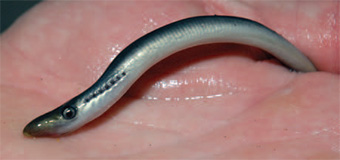Sea lamprey
A fact sheet about sea lamprey, an invasive, eel-like fish first introduced in the early 20th century.
Sea Lamprey (Petromyzon marinus)
The Sea Lamprey is a primitive, eel-like fish native to the northern Atlantic Ocean and the Baltic, western Mediterranean and Adriatic seas. Sea Lampreys invaded the Great Lakes in the early 20th century through shipping canals.
In their native range, Lampreys live part of their lives in salt water, but they have adapted to living entirely in fresh water in the Great Lakes. As adults they spawn in rivers and streams. The eggs hatch into larvae that live on organic matter in stream bottoms until they transform into parasites that migrate downstream to lakes. The adult Lampreys spend 12 to 20 months feeding on the blood of other lake-dwelling fish, until they are ready to travel upstream to spawn. The complete life cycle usually lasts five to nine years.

Range
The native range of the sea lamprey includes the Atlantic coast of North America from Newfoundland to northern Florida, the Atlantic coast of Europe, and the Baltic, western Mediterranean and Adriatic seas. Today Sea Lampreys are also found in all of the Great Lakes. Sea Lamprey larvae live in Great Lakes tributaries that have suitable habitat until they become juveniles or “transformers.”
Impacts of Sea Lamprey in the Great Lakes
The devastating impact of the sea lamprey on Great Lakes sport, commercial and Aboriginal fisheries in the 1940s and 50s led Canada and the United States to form the Great Lakes Fishery Commission in 1955. Since then the commission has led a program to assess and control the species using measures that target different stages of its life cycle. These include chemicals that selectively kill lamprey larvae, and barriers and traps that prevent adult Lampreys from moving upstream to spawn.

Photo: Great Lakes Sea Grant Network
Although it is likely impossible to eliminate the sea lamprey from the Great Lakes, ongoing efforts to control the species have reduced populations by 90 per cent. Unfortunately, the remaining Sea Lampreys continue to affect native fish species.
- The sea lamprey uses its sucker mouth, sharp teeth and rasping tongue to attach itself to the body of a fish and suck the fish’s blood. Fish that survive the attack are left with a large open wound that can become infected and often leads to death.
- During its parasitic phase, one sea lamprey can destroy an average of 18 kilograms of fish.
- As few as one in seven fish may survive a sea lamprey attack. Attacks have resulted in reduced stocks of lake trout, salmon, whitefish, cisco and burbot in the Great Lakes.

What you can do
- Learn how to identify sea lamprey and how to prevent the spread of this unwanted species.
- Don’t put any live fish into Ontario waters.
- Don’t help Sea Lampreys pass over dams and culverts that block their spawning migration.
- If you catch a fish with a sea lamprey attached, do not return the sea lamprey to the water. Kill it and put it in the garbage.
- For questions on sea lamprey or the Sea Lamprey Control Program, contact the Sea Lamprey Control Centre of Fisheries and Oceans Canada in Sault Ste. Marie at
1-800-553-9091 , or learn more about fighting Sea Lampreys with science. - Report other invasive species sightings to the Invading Species Hotline at
1-800-563-7711 , or visit invadingspecies.com to report a sighting.
How to identify Sea Lamprey
Adult
- Cylindrical bodies are 30 to 76 centimetres long with no scales.
- Leathery skin is grey to dark brown with dark blotches and a lighter belly.
- Sharp teeth radiate around a rasp-like tongue at the centre of a large sucker mouth.
- The fish has large eyes, two dorsal fins, no pelvic or pectoral fins, a single, mid-dorsal nostril, and seven obvious gill openings on each side.

Photo: T. Lawrence, GLFC
Larvae
- Larvae are up to 18 centimetres long, blind and wormlike, with a black to pale grey body and a light underside.
- In larvae four centimetres or longer, the first and second dorsal fins are distinctly separate.
Similar native species include silver lamprey (Ichthyomyzon unicuspis), chestnut lamprey (I. castaneus), northern brook lamprey (I. fossor), American brook lamprey (Lampetra appendix) and American eel (Anguilla rostrata).

Photo: T. Lawrence, GLFC

For more information:
Please contact the Invading Species Hotline at